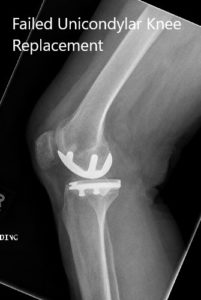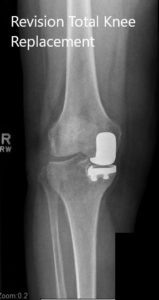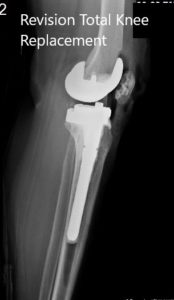Case Study: Revision Total Knee Replacement
in a 68-year-old male with prior Unicondylar Knee Replacement
A retired banker presented to our office with worsening right knee pain. The pain was first noticed 6 months back when he was walking his dog. The pain subsequently got worse and disturbed his sleep. He had a partial knee replacement done by another physician about 5 years back for osteoarthritis of the medial compartment of the knee.
The pain was described as a dull ache which was non-radiating. The intensity of the pain was described as severe on activities and moderate on rest. The pain was especially worse on activities such as walking, getting up from a chair, climbing stairs, bending, kneeling, turning and twisting. He denied any associated fall or trauma.
He was currently taking over the counter pain medications. He denied any recent history of fever or redness of the knee. He complained of excessive stiffness on prolonged periods of rest. Currently, the pain severely restricted his daily activities. He was currently living with his daughter who accompanied him for the doctor’s office visit.
He was a former smoker having quit 10 years ago. He denied any known drug allergies. He was currently taking medications for hypothyroidism, asthma and high blood pressure. All his medical issues were well controlled with medications. Besides the Unicondylar knee replacement, He had a laparoscopic hernia repair 2 years ago and arthroscopic shoulder surgery a year ago.
On physical examination, there was mild swelling in the right knee. There was no rise in local temperature. The skin incision from the previous surgery was well healed. The gait of the patient was antalgic with a reduced stance phase on the right side. There was tenderness on the medial and lateral joint lines.
There was tenderness on patellar facets. Valgus and varus stress test at 0 degrees, 30 degrees, and 60 degrees was negative. Anterior drawer, posterior drawer, and Lachman test was negative as well. The entire arch of motion was painful. The range was from 10 degrees to 110 degrees.
The examination of the left knee, bilateral hips and ankles were normal. There was no distal neurological deficit. The bilateral lower extremity pulses were palpable and comparable. There was no bowel or bladder dysfunction. The lower extremity deep tendon reflexes were present and comparable.
He was advised a knee aspiration for gram staining, culture sensitivity, and biochemistry. He was also advised blood tests in the form of Hb, TLC, DLC, ESR and CRP (qualitative and quantitative).
The knee aspiration tests were negative for infection. The blood tests ruled out any active infection. The imaging studies revealed the failure of the Unicondylar knee replacement. He was advised for revision surgery in the form of total knee replacement. Risks, benefits, and alternatives were discussed at length with the patient. The patient agreed with the plan.


Preoperative X-ray of the right knee in anteroposterior and lateral views.
PREOPERATIVE DIAGNOSIS: Failed medial unilateral knee replacement.
IMPLANT USED: Tibial component size 2 with a stem extension 13 mm x 100 mm in length with size 2. 5-mm medial augment with flex 17 mm polyethylene with 32-mm patella, B.5-mm thickness, with Flex femoral component size C.
PROCEDURE: The patient was brought to the operating room after obtaining informed consent and signing the correct surgical site. The risks. benefits. and alternatives were extensively discussed with the patient prior to the procedure. The patient understands the increased risk of knee revision surgically.
The patient was definitively positioned and the right lower extremity was then draped and prepped in the usual sterile manner. Tourniquet cuff was placed over the right thigh. A time-out was performed. Antibiotics were given and the Esmarch was used and the tourniquet was then elevated.
The earlier incision was used for the arthrotomy. It was extended proximally and distally. Skin and subcutaneous tissues were incised. Medial parapatellar arthrotomy was then performed. The scar tissue was removed.
The tibia was then repaired. The component was loose and was removed. The tibia was drilled and then, the resection was made in the tibia to the fresh bone.
The tibia was then sized and it was decided to put a 5-mm augment on the medial side. The tibia was then prepared. Attention was then towards the femur. The femoral uni component was then removed. The distal and sample cuts were made on the femur.
The notch cut was then prepared. Medial and lateral laminar spreaders were used and the medial and the lateral cruciates and meniscus were then debrided. The gap was balanced in flexion and in extension.
Attention was then turned towards the patella after removing the scar tissue. The patellar excision was then performed and the trial patella was then placed into position. The trial femur was placed. The trial tibia was placed and trial poly was placed into position. The knee was then trialed through a full range of motion. The patellar tracking was good. The knee was stable in all range of motion.
The trial components were then removed. The femur was cemented into position. The tibia was cemented into position. Poly was then placed into position and the knee was held in full extension with a bump under the ankle. Patella was cemented into position and was held in position with a patellar clamp. Excess cement was then removed.
After the cement hardened. the knee was then again trialed and it was felt that the knee was loose in flexion as well as in extension. The knee was then trialed with 17-mm poly and was found to be stable in physiological flexion and extension. The earlier poly size was 12 mm.
The new poly size was 17 mm. Full extension and full flexion were obtained with the knee. Thorough lavage was given. The injection was given for pain control. Medial parapatellar arthrotomy was closed with Vicryl.
Cutaneous tissues were closed with #0 Vicryl. subcuticular tissues were closed with 2-0 Vicryl and skin was closed using Monocryl. Sterile dressing was then applied over the wound. The patient was then transferred to the postoperative care unit in stable condition.


Postoperative X-ray showing the lateral and anteroposterior views of the right knee.
Post-op him vitals remained stable and he was able to walk the same day of the surgery. His pain was managed with medications and aspirin was prescribed for deep vein thrombosis prophylaxis. The patient was advised by physical therapy and home exercise programs to increase flexibility and strengthen the muscles.
The sutures were examined to be clean, dry and intact. Three months post-op He demonstrated a full range of motion of the right knee with no pain. He was active again and expressed satisfaction at the results of the procedure. He was performing all his daily activities with ease.
Disclaimer – Patient’s name, age, sex, dates, events have been changed or modified to protect patient privacy.
My name is Dr. Suhirad Khokhar, and am an orthopaedic surgeon. I completed my MBBS (Bachelor of Medicine & Bachelor of Surgery) at Govt. Medical College, Patiala, India.
I specialize in musculoskeletal disorders and their management, and have personally approved of and written this content.
My profile page has all of my educational information, work experience, and all the pages on this site that I've contributed to.

